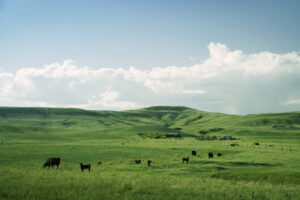How Mother Nature Hedges Her Bets
This article written by Dr. Reynold Bergen, BCRC Science Director, originally appeared in the May 2021 issue of Canadian Cattlemen magazine and is reprinted on the BCRC Blog with permission of the publisher.
Pasture plants are generally classified as decreasers, increasers and invaders. Decreaser species are the plants you want to see and your cattle prefer to eat, so they face the most grazing pressure. Increaser plants tend to thrive when the decreaser species are challenged by overgrazing, drought or other sub-optimal conditions. Invaders (weeds) proliferate when increasers and the remaining decreasers are so weakened by overgrazing or environmental extremes that they have a hard time competing for nutrients, water and sunlight.
Healthy, productive pastures are dominated by decreasers. The composition of the decreaser community in healthy native rangelands was shaped by thousands of years of natural selection and environmental pressures. In tame pastures, humans take the wheel from Mother Nature as we seek to establish and maintain a stand of tame decreaser species that can be productive and long-lived in our particular soil and climate conditions. In both native and tame pastures, good grazing managers adjust stocking densities, grazing intensities, grazing and rest period length and frequency, etc. based on annual and seasonal variations in growing conditions to maintain pasture health and optimize long-term forage and animal productivity.
Different growing conditions affect different forage species differently, so even a healthy, well-managed pasture experiences some back-and-forth between different decreaser plant species in response to year-to-year variations in weather or grazing pressure. As part of a larger and longer-term Beef Cluster project aimed at developing new tame and native varieties and mixtures with improved forage yields and pasture resilience, researchers at Agriculture and Agri-Food Canada’s Swift Current Research Station studied how bunchgrasses and sod-forming grasses respond to drought and grazing. These results were published under the amazing title of Drought weakens the positive effects of defoliation on native rhizomatous grasses but enhances the drought‐tolerance traits of native caespitose grasses in 2018 (Ecology and Evolution DOI: 10.1002/ece3.4671).
What They Did:
Two sod-forming grasses (western wheatgrass and northern wheatgrass) and two bunchgrasses (needle-and-thread grass and western porcupine grass) native to Western Canada were grown in separate pots under controlled greenhouse conditions. Each grass was exposed to four different moisture levels (100%, 85%, 70% and 55% of field capacity). “Field capacity” refers to how much water the soil can hold. At 100% field capacity, the soil is “full”; any more water that is added will either run off, recharge groundwater, or both. The 85%, 70% and 55% treatments reflected slight, moderate and severe drought conditions. To simulate grazed and ungrazed conditions under each moisture level, plants were either clipped back to a height of 5 cm, twice (one month apart) or not clipped at all. Plant height, leaf length, and numbers of tillers and leaves were measured, and forage yields and root growth responses were measured for each plant.
What They Learned:
The western porcupine and needle-and-thread bunchgrasses were generally shorter but had more tillers and more (but shorter) leaves than the sod-forming western and northern wheatgrasses.
Bunchgrasses were less productive under optimal moisture conditions but were more drought-tolerant than the sod-forming grasses. Western porcupine grass displayed relatively stable forage yields regardless of drought severity. Needle-and-thread grass had stable forage yields under slight and moderate drought but significantly lower yields under severe drought conditions. Both bunchgrasses also tended to show slightly more root growth under slight and moderate drought. Clipping had minimal effects on total forage yield for either bunchgrass, but it reduced root growth (particularly for western porcupine grass) under more severe drought conditions.
Sod-forming grasses were twice as productive as bunchgrasses under good moisture conditions, but their yields decreased sharply as drought conditions worsened, to the point that they were no more productive than bunchgrasses under severe drought. Root growth mirrored the same pattern as forage yields. Clipping increased the forage yield of western and northern wheatgrasses under no or slight drought, but not under severe drought. Clipping progressively reduced the root growth of both western and northern wheatgrasses.
So What Does This Mean … to Me?
Everyone knows that severe drought and over-grazing weakens desirable forage plants. But not all plants respond the same way to the same growing and grazing conditions. Mother Nature has adapted to yearly variations in moisture and temperature patterns by designing plant communities that contain species that thrive in cooler or moister than average conditions as well as other species that cope better with harsher than usual growing seasons.
A high producing monoculture could probably produce higher yields under ideal conditions. But few growing seasons are ideal, particularly on the marginal soils that are often used for pasture. Well-managed grasslands maintain a variety of different forage species, ensuring that there are always some species present that will be able to survive and potentially thrive no matter what the weather has in store. Mother Nature optimizes, trading maximum yields under ideal conditions for resilience under normal or extreme conditions. Good grazing management helps her do that.
Next month’s column will talk about a few other tricks that forage plants have up their leaves that they can use to compete with weeds and other invader species.
The Beef Cattle Research Council is funded by the Canadian Beef Cattle Check-Off. The BCRC partners with Agriculture and Agri-Food Canada, provincial beef industry groups and governments to advance research and technology transfer supporting the Canadian beef industry’s vision to be recognized as a preferred supplier of healthy, high quality beef, cattle and genetics.
Click here to subscribe to the BCRC Blog and receive email notifications when new content is posted.
The sharing or reprinting of BCRC Blog articles is typically welcome and encouraged, however this article requires permission of the original publisher.
We welcome your questions, comments and suggestions. Contact us directly or generate public discussion by posting your thoughts below.
